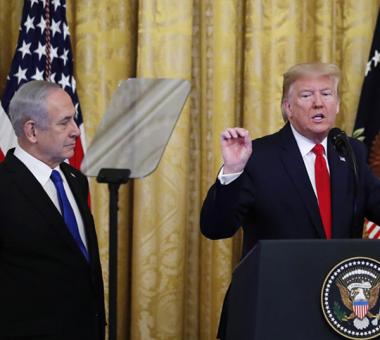The Day After “The Deal”
After announcing the “Deal of the Century” to resolve the Israeli-Palestinian conflict, what are its implications on the course of the peace process in general? And will this plan be treated as a new reference point, or will it be a mere non-binding proposal?
by STRATEGIECS Team
- Publisher – STRATEGEICS
- Release Date – Jan 29, 2020

Peace proposals have always been raised across the decades-long Palestinian-Israeli conflict; however, these proposals presented various details and showed different levels of the political will sustaining them. All these proposals, including the "deal", overlooked serious endeavors to create a suitable condition so as to establish a social environment that fosters the peace process. The sequence of extremism and its counterpart extremism is still prevalent in historical Palestine, and the deliberate psychological pressure still evokes several events with negative consequences on the potential for achieving sustainable peace.
Yesterday, U.S. President Donald Trump announced in a press conference his administration's plan to resolve the Palestinian issue and achieve peace between the Palestinians and Israelis. An announcement that came after more than three years of preparation and discussions in the White House and with decision-making units in the Middle East. There have also been media leaks through official and unofficial channels about this plan, which came to be known as the "Deal of the Century".
For his part, Israeli Prime Minister of the caretaker government Benjamin Netanyahu and his main political rival Benny Gantz, leader of the Blue and White Alliance, have approved the plan, perceiving it as the optimal means of achieving peace; both also pledged to realize the plan upon winning the upcoming Knesset elections in March 2020.
The plan's major clauses could be seen as a documentation of what is already in place since the U.S. previously recognized Jerusalem as an undivided capital of Israel, while the plan states the "future" Palestinian state's ability to annex limited parts of East Jerusalem. Moreover, the plan endorsed Israel's future annexation of around 30% to 40% of the West Bank’s territory. This clause is in line with U.S. Secretary of State Mike Pompeo's announcement in November 2019, stating that Israeli settlements in the West Bank do not contradict International law. The deal also meets electoral promises repeatedly made by Netanyahu and Gantz regarding the annexation of settlements to Israel and claiming sovereignty over the Jordan Valley and northern Dead Sea.
Some perceive the timing of the announcement as an attempt to support the U.S. administration's current ally in Israel, i.e. Benjamin Netanyahu; in order to help him in resolving his country's political crisis that has been in place since April 2019. This proposition, however, can be refuted by Trump's invitation to Benny Gantz for the meeting where he participated in discussing aspects of the plan. Yet, the success chances of the right-wing camp led by the Likud party may increase during the upcoming election in case the caretaker government begins practical measures to implement some of the plan's "entitlements" on Israel. Otherwise, the hope for adopting the plan remains in forming a national coalition government between the Likud and the Blue and White alliance. Hence, Trump will succeed in finding a joint file that is of major importance for the Israeli political rivals; this is against the backdrop that current U.S. administration’s trends will remain the same even after presidential elections in November 2020, particularly in terms of its figures and adopted approaches toward controversial issues in the world. Furthermore, pulling back or restructuring the plan based on deeper discussions with concerned parties will remain probable in case Democrats return to the White House.
As for the Palestinian National Authority, it is evident that accepting Trump’s plan is standing at a deadlock, which was initially apparent more than two years prior to its announcement. Thus, the future implementation of this plan requires changing the structure of the Palestinian political elite, eventually raising the question: who will lead the next stage and will they gain popular approval? This will be determined by the nature and dimensions of the political discourse they employ. The most complicated issue remains in the demilitarization of armed factions in the Gaza Strip from their military capabilities since the plan includes a demilitarized state in general.
On the Arab and international levels, statements –ranging between rejection and support– issued by countries of different sizes and varying extents of influence on the course of political and economic events in the world show that the plan will be a specific and significant part of any negotiating process between Palestinians and Israelis. Nonetheless, the debate will continue over the consistency of the aforementioned plan with relevant international legitimacy resolutions.
Initially, the deal appears to focus on realistic terms such as facts on the ground, authority, power, and a realistic two-state solution; however, it neglected the historical dimension on which the realistic theory is based in terms of methodology and analysis. The project theorists envisioned that the "identity" aspect of the conflict can be simply resolved; for instance, under its fifth section titled "Jerusalem," the plan proposes establishing a Jerusalem-Al Quds Joint Tourism Development Authority, abbreviated “JTDA”.
According to the proposal, a special tourism zone will be established in "Atarot", which will be a springboard for tourism in the city in coordination with Israelis after negotiating the mechanisms that will be adopted, provided that a portion of the revenues will go to the proposed tourism authority.
The U.S. peace plan alleviates “The Primacy of Security" and Israel’s freedom to act against what it perceives as a threat to its security. As such, the plan emphasizes the need for all parties to unite in combating and confronting terrorism as a threat to the promised prosperity process. Some specialists in the psychology of terrorism argue that the prevalent frustration among several youths in the region develops an incubating environment for adopting extremist ideas. It is also concerning that the attempts to legitimize imposing a fait accompli on Palestinians will increase the tendency for extremist ideas due to the growing awareness in the inability to reach a just and logical political solution.
In conclusion, the U.S. plan may increase the Israeli appetite and fuel the Palestinian anger, and the peace process will remain in a push-pull range with no indication of Palestinians and Israelis returning to the direct bilateral negotiating table. This does not necessarily mean that the deal failed in practice since its objective may not be immediate, but this deal may serve as a reference to the U.S. foreign policy when addressing the Palestinian-Israeli conflict.
Follow the link to read the full text of the American “Middle East Peace Plan”

STRATEGIECS Team
Policy Analysis Team
 العربية
العربية